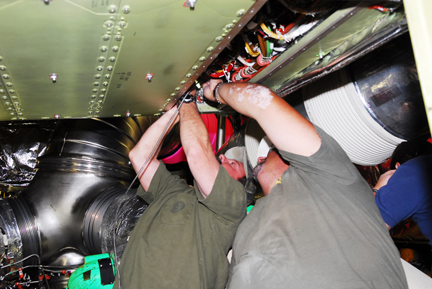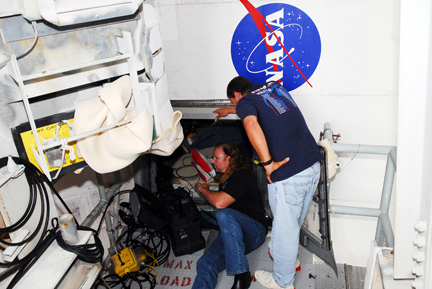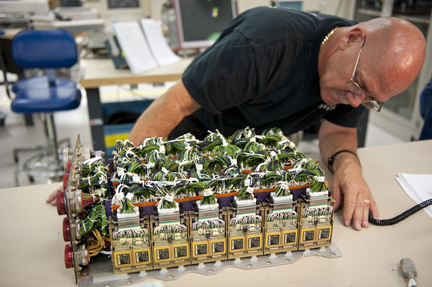Shuttle Endeavour cleared for May 16 launch try
By WILLIAM HARWOOD
CBS News
KENNEDY SPACE CENTER, FL--NASA managers met Monday and cleared the shuttle Endeavour for a second launch try May 16 after weekend work to re-wire and re-test hydraulic power system fuel line heaters blamed for derailing an April 29 launch attempt.
"Right now, we're in good shape," said Launch Director Mike Leinbach. "Endeavour's looking good, the team is upbeat. I went to the meeting this morning and they're ready to go. Hopefully, this time the heaters will work and we'll be able to launch on time next Monday morning."
While engineers have not yet found the root cause of a short circuit that effectively blew a fuse in a power supply circuit, the replacement of critical hardware, installation of by-pass wiring and extensive testing have given agency managers confidence the problem has been resolved.
"We've replaced everything except the heaters, and we've wrung those out with at least five separate checks and full functionals afterwards and now have extremely high confidence that the problem is no longer on the ship or in any of the electronics," said Mike Moses, director of shuttle integration at the Kennedy Space Center.
"We don't still exactly have root cause, but we basically have really good, comprehensive proof that we have managed to remove that failure."
Assuming final tests and checkout go smoothly, engineers will restart Endeavour's countdown at 7 a.m. EDT (GMT-4) Friday, setting up a launch at 8:56:26 a.m. Monday, roughly the moment Earth's rotation carries launch pad 39A into the plane of the International Space Station's orbit.
Endeavour's crew -- commander Mark Kelly, pilot Gregory H. Johnson, Michael Fincke, Gregory Chamitoff, Andrew Feustel and European Space Agency astronaut Roberto Vittori -- plans to fly back to Florida Thursday morning to prepare for launch. Kelly's wife, Arizona Rep. Gabrielle Giffords, recovering from a January assassination attempt, is expected to attend the launching, but her schedule is not yet known.
Thanks to the launch slip, Endeavour's 25th and final flight will be carried out in the deep overnight hours U.S. time, with docking at the International Space Station expected at 6:15 a.m. on May 18. Four spacewalks are planned, on May 20, 22, 25 and 28, before undocking around 11:52 p.m. on May 29 and landing back at the Kennedy Space Center around 2:32 a.m. on June 1.
The two-week delay has forced NASA to consider a corresponding slip for NASA's final planned shuttle mission, pushing launch of the Atlantis from June 28 to around July 15. Moses said a firm target date will not be set until after Endeavour gets off the ground and engineers get a better idea of how much launch pad damage they might have to repair and how much work remains to ready Atlantis for flight.
The Endeavour astronauts will face a more challenging timeline than usual because of the departure of three space station crew members -- Expedition 27 commander Dmitry Kondratyev, Paolo Nespoli and NASA flight engineer Catherine Coleman -- on May 23 aboard the Soyuz TMA-20 spacecraft.
The departing astronauts must sleep shift to accommodate the Soyuz landing time, putting them out of synch with the shuttle crew's sleep schedule. As it is, Kelly and his crewmates will be asleep when the Soyuz undocks.
NASA flight planners are revising the shuttle timeline to make sure the departing station crew members are not disturbed as they adjust their sleep cycle to accommodate re-entry and landing and to make sure needed station maintenance gets done before Endeavour's departure.
Mission managers decided earlier to extend Endeavour's mission by two days to simplify flight planning. But orchestrating the required work with multiple sleep schedules remains a significant challenge.
"This one's pretty close to the edge," Moses said. "A sleep shift another hour or two worse than this would probably tell us we can't do it. So this is about the furthest we'd want to stretch for a dual docked operation."
Endeavour was grounded April 29 when one of two "strings" of fuel line heaters used by one of the shuttle's three hydraulic power units failed to power up normally. While the system can safely operate with a single string, a subsequent failure could result in a fuel line rupture, knocking auxiliary power unit No. 1 out of action and possibly contaminating the aft engine compartment with toxic hydrazine.
NASA managers stopped the countdown and ordered an investigation to find out what went wrong. There were three possible explanations: trouble with a fuse panel in the shuttle's cockpit that routes power to the APU system; a problem with the aft load control assembly, an electrical distribution box upstream of the heaters; or trouble with downstream heaters, thermostats and wiring.
Subsequent testing showed the cockpit fuse panel was working normally and that commands were reaching ALCA No. 2 as required. Additional tests indicated the thermostats in question were healthy but not getting power from the distribution box. As a result, ALCA No. 2 was removed from avionics bay No. 5 in Endeavour's aft engine compartment for a detailed failure analysis.
Engineers quickly found vaporized fuse elements in a so-called "hybrid driver" circuit responsible for routing power to APU 1's B-string fuel line heaters. But it's not yet known whether the blown circuitry was the result of a problem inside the power box or the result of a short in external wiring.
At launch pad 39A, meanwhile, a replacement ALCA was installed, but fuel line heater power was not immediately reconnected to make sure whatever caused the initial problem did not damage the replacement box.
Engineers met late last week and discussed three options: replacing the wiring between ALCA No. 2 and the heater thermostats; replacing all the wiring, thermostats and heaters downstream of ALCA No. 2; and pressing ahead "as is" with the replacement ALCA and the original wiring.
They opted to replace the wiring between ALCA No. 2 and the heaters. That work was carried out over the weekend. The new line, which Moses estimated was about 20 feet long, was plugged into ALCA-2, the system was activated and tests showed the heaters were receiving power as required. Work was underway Monday to remove access platforms from the shuttle's engine compartment and to re-install an access door to prepare the ship for flight.
"We ran a whole bunch of tests," Moses said. "We did continuity checks ... and made sure that wire was intact and didn't go to ground anywhere. We measured the resistance of this line, it measured within family of what the resistance of the heater measured the last time it was checked about two years ago. We saw no changes in the resistance of these heaters, we saw no open circuits with the continuity checks.
"We did what we call a high-pot, or high potential, check of all the orbiter wiring and the heaters where you basically put high voltage, but low current, into the system and you'll see that voltage jump across any gaps if there is an insulation breakdown, it would show up as that high pot test grounded itself out. And we saw no problems in either the orbiter wiring or in the heaters.
"Then we did functional checks, which culminated last night in our full up retest of this APU system where we basically operated the heaters on both an external power supply and then the new (ALCA-2) power supply," Moses said. "And we saw full functionality out of all five of these heaters as they were supposed to work."
Engineers will be monitoring the system closely next Monday when the shuttle is loaded with supercold propellants. As the temperature in the aft engine compartment drops, the fuel line thermostats should respond, powering the heaters on as needed.
If the heaters again fail to activate, Moses said mission managers will consider pressing ahead with launch anyway given the redundancy in the system and the knowledge that major elements have been replaced.
But that remains to be seen. NASA's launch commit criteria require both heater strings to be operational for a countdown to proceed and it's not yet clear if a waiver would be a viable option.
In any case, mission managers are confident it won't come to that. Engineers are continuing to test the suspect ALCA that was removed from Endeavour "but it's going to take a long time until we can say we definitely found a problem inside that box," Moses said.
"And so we wanted to make sure our flight rationale didn't need us to have that root cause and by replacing the box and replacing the wiring, we think we have that."
In a bit of late-breaking news, Moses said engineers reviewing test data collected last June have found evidence of a previously unknown 10-amp spike during a heater thermostat test carried out in the shuttle's processing hangar. Whether that spike was the result of a short that could explain the problem seen April 29 is not yet known.
The thermostat in question was replaced as part of the on-going troubleshooting and "if this turns out to be the root cause, we've removed it from the ship," Moses said.
CBS News
KENNEDY SPACE CENTER, FL--NASA managers met Monday and cleared the shuttle Endeavour for a second launch try May 16 after weekend work to re-wire and re-test hydraulic power system fuel line heaters blamed for derailing an April 29 launch attempt.
"Right now, we're in good shape," said Launch Director Mike Leinbach. "Endeavour's looking good, the team is upbeat. I went to the meeting this morning and they're ready to go. Hopefully, this time the heaters will work and we'll be able to launch on time next Monday morning."
While engineers have not yet found the root cause of a short circuit that effectively blew a fuse in a power supply circuit, the replacement of critical hardware, installation of by-pass wiring and extensive testing have given agency managers confidence the problem has been resolved.
 |
| Engineers wrap up work to install, test and close out a replacement electrical distribution box in the shuttle Endeavour's aft engine compartment. Trouble with hydraulic system fuel line heater circuits controlled by the distribution system derailed an April 29 launch try. (Credit: NASA) |
"We don't still exactly have root cause, but we basically have really good, comprehensive proof that we have managed to remove that failure."
Assuming final tests and checkout go smoothly, engineers will restart Endeavour's countdown at 7 a.m. EDT (GMT-4) Friday, setting up a launch at 8:56:26 a.m. Monday, roughly the moment Earth's rotation carries launch pad 39A into the plane of the International Space Station's orbit.
Endeavour's crew -- commander Mark Kelly, pilot Gregory H. Johnson, Michael Fincke, Gregory Chamitoff, Andrew Feustel and European Space Agency astronaut Roberto Vittori -- plans to fly back to Florida Thursday morning to prepare for launch. Kelly's wife, Arizona Rep. Gabrielle Giffords, recovering from a January assassination attempt, is expected to attend the launching, but her schedule is not yet known.
Thanks to the launch slip, Endeavour's 25th and final flight will be carried out in the deep overnight hours U.S. time, with docking at the International Space Station expected at 6:15 a.m. on May 18. Four spacewalks are planned, on May 20, 22, 25 and 28, before undocking around 11:52 p.m. on May 29 and landing back at the Kennedy Space Center around 2:32 a.m. on June 1.
 |
| Engineers test replacement wiring in the shuttle Endeavour's engine compartment. (Credit: NASA) |
The Endeavour astronauts will face a more challenging timeline than usual because of the departure of three space station crew members -- Expedition 27 commander Dmitry Kondratyev, Paolo Nespoli and NASA flight engineer Catherine Coleman -- on May 23 aboard the Soyuz TMA-20 spacecraft.
The departing astronauts must sleep shift to accommodate the Soyuz landing time, putting them out of synch with the shuttle crew's sleep schedule. As it is, Kelly and his crewmates will be asleep when the Soyuz undocks.
NASA flight planners are revising the shuttle timeline to make sure the departing station crew members are not disturbed as they adjust their sleep cycle to accommodate re-entry and landing and to make sure needed station maintenance gets done before Endeavour's departure.
Mission managers decided earlier to extend Endeavour's mission by two days to simplify flight planning. But orchestrating the required work with multiple sleep schedules remains a significant challenge.
"This one's pretty close to the edge," Moses said. "A sleep shift another hour or two worse than this would probably tell us we can't do it. So this is about the furthest we'd want to stretch for a dual docked operation."
Endeavour was grounded April 29 when one of two "strings" of fuel line heaters used by one of the shuttle's three hydraulic power units failed to power up normally. While the system can safely operate with a single string, a subsequent failure could result in a fuel line rupture, knocking auxiliary power unit No. 1 out of action and possibly contaminating the aft engine compartment with toxic hydrazine.
NASA managers stopped the countdown and ordered an investigation to find out what went wrong. There were three possible explanations: trouble with a fuse panel in the shuttle's cockpit that routes power to the APU system; a problem with the aft load control assembly, an electrical distribution box upstream of the heaters; or trouble with downstream heaters, thermostats and wiring.
Subsequent testing showed the cockpit fuse panel was working normally and that commands were reaching ALCA No. 2 as required. Additional tests indicated the thermostats in question were healthy but not getting power from the distribution box. As a result, ALCA No. 2 was removed from avionics bay No. 5 in Endeavour's aft engine compartment for a detailed failure analysis.
Engineers quickly found vaporized fuse elements in a so-called "hybrid driver" circuit responsible for routing power to APU 1's B-string fuel line heaters. But it's not yet known whether the blown circuitry was the result of a problem inside the power box or the result of a short in external wiring.
 |
| A suspect power distribution box from the shuttle Endeavour is undergoing additional tests to determine the cause of a short circuit found in a circuit board power supply. (Credit: NASA) |
Engineers met late last week and discussed three options: replacing the wiring between ALCA No. 2 and the heater thermostats; replacing all the wiring, thermostats and heaters downstream of ALCA No. 2; and pressing ahead "as is" with the replacement ALCA and the original wiring.
They opted to replace the wiring between ALCA No. 2 and the heaters. That work was carried out over the weekend. The new line, which Moses estimated was about 20 feet long, was plugged into ALCA-2, the system was activated and tests showed the heaters were receiving power as required. Work was underway Monday to remove access platforms from the shuttle's engine compartment and to re-install an access door to prepare the ship for flight.
"We ran a whole bunch of tests," Moses said. "We did continuity checks ... and made sure that wire was intact and didn't go to ground anywhere. We measured the resistance of this line, it measured within family of what the resistance of the heater measured the last time it was checked about two years ago. We saw no changes in the resistance of these heaters, we saw no open circuits with the continuity checks.
"We did what we call a high-pot, or high potential, check of all the orbiter wiring and the heaters where you basically put high voltage, but low current, into the system and you'll see that voltage jump across any gaps if there is an insulation breakdown, it would show up as that high pot test grounded itself out. And we saw no problems in either the orbiter wiring or in the heaters.
"Then we did functional checks, which culminated last night in our full up retest of this APU system where we basically operated the heaters on both an external power supply and then the new (ALCA-2) power supply," Moses said. "And we saw full functionality out of all five of these heaters as they were supposed to work."
Engineers will be monitoring the system closely next Monday when the shuttle is loaded with supercold propellants. As the temperature in the aft engine compartment drops, the fuel line thermostats should respond, powering the heaters on as needed.
If the heaters again fail to activate, Moses said mission managers will consider pressing ahead with launch anyway given the redundancy in the system and the knowledge that major elements have been replaced.
But that remains to be seen. NASA's launch commit criteria require both heater strings to be operational for a countdown to proceed and it's not yet clear if a waiver would be a viable option.
In any case, mission managers are confident it won't come to that. Engineers are continuing to test the suspect ALCA that was removed from Endeavour "but it's going to take a long time until we can say we definitely found a problem inside that box," Moses said.
"And so we wanted to make sure our flight rationale didn't need us to have that root cause and by replacing the box and replacing the wiring, we think we have that."
In a bit of late-breaking news, Moses said engineers reviewing test data collected last June have found evidence of a previously unknown 10-amp spike during a heater thermostat test carried out in the shuttle's processing hangar. Whether that spike was the result of a short that could explain the problem seen April 29 is not yet known.
The thermostat in question was replaced as part of the on-going troubleshooting and "if this turns out to be the root cause, we've removed it from the ship," Moses said.